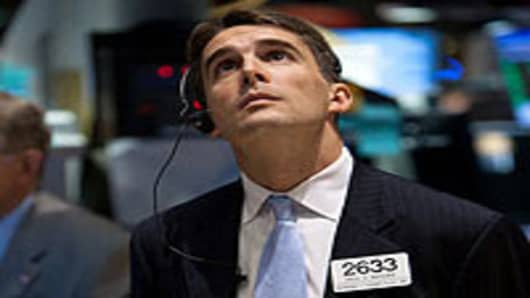Though the market is coming off its best quarter in 13 years, the rally has been accomplished with only sporadic help from the mom-and-pop investors counted on to power the US economy.
While stocks surged, retail investors took money out and hedge funds plowed in, posting their biggest inflows ever in March while equity mutual funds broke a two-month streak of positive flows.
Another trend intensified: On up days market volume was weak—often less than a billion shares a day on the New York Stock Exchange—while down days saw significantly greater conviction as investors sought safety and the so-called "risk-off" trade.
It all amounts to a pretty resounding no-confidence vote in a market that nonetheless has nearly doubled the cycle lows it saw in the dour days of March 2009.
"All the fundamentals are good. We just had a very good labor report, the earnings picture is still very robust, there's a lot of momentum in the economy," says Brian Gendreau, market strategist with Financial Network, based in El Segundo, Calif. "But it doesn't seem to be translating into great enthusiasm for equities on the part of retail investors."
Primary volume on the NYSE has been below a billion shares for eight of the past nine sessions, reversing a run above that figure for six straight trading days. That indicates the likelihood that most retail investors are sitting out the market as headwinds from inflation, geopolitical turmoil and the natural disaster in Japan whip through.
Responsibility for the rally largely, then, falls into the hands of the institutional investors and the big hedge fund managers whose access to large sums of capital moves the markets.
It's no wonder, considering that the Federal Reserve's program—quantitative easing, or QE—is targeted directly at buying Treasurys from large institutions who then are expected to use the proceeds to invest in risk assets like stocks.
In a perfect world, that generates a virtuous cycle in which retail investors follow the example of large funds and get into stocks. But that's been an elusive goal so far.
"Fund flows suggest that the retail investors are moving finally out of bonds and into stocks," Gendreau says. "But it's a slow and small process. It's baby steps."
Retail investors redeemed about $7 billion in equity funds during March—$4.6 billion from mutual funds and $2.4 billion from exchange-traded funds—even as the hedge funds upped their investments, according to TrimTabs.
"This marks the first dual outflow since August 2010," the firm said in its weekly market analysis. "Retail investors are ditching domestic stocks even though the average US equity fund has posted seven straight positive monthly returns."
That came after more than $20 billion in net inflows for January and February, according to data from the Investment Company Institute, which reported an almost uninterrupted flow of taxable bond fund inflows since early 2009.
Nonetheless, the flow to bonds has been about halved since November, indicating some swing in investor sentiment.
"Every time I'm thinking about rearranging my portfolio something happens where Treasurys catch a bid," says Kim Rupert, managing director of global fixed income analysis for Action Economics in San Francisco. "But it looks like stocks are feeling pretty good."
The rotation in bond funds indicates at least a grudging move from fixed income into equities.
"Downside risks for the bond market are fairly low," insists Robert Tipp, chief investment strategist at Prudential Fixed Income in Newark, N.J. "Fixed-income securities are going to provide a better real return for investors than money fund assets as well as a ballast to the performance of the equity markets."
Optimists are hoping, though, that more aggressive involvement from retail investors will pave the way for another leg of the rally.
Though money market mutual funds are near a post-financial crisis low of $2.735 trillion, that still represents a tidy sum not earning anything and ready for deployment.
"Here's a perfect example of strong price action without volume," says Sam Stovall, chief equity strategist at Standard & Poor's. "You could say that would be a reason why this bull market will last longer than some people anticipate—because so many people are still on the sidelines."



